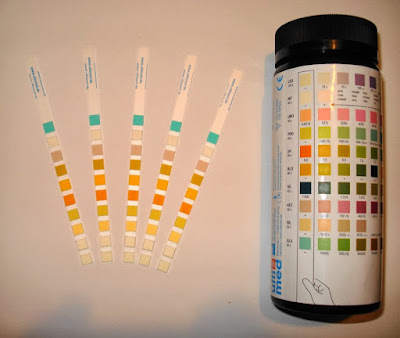From Lab to Home: A Patient's Experience Using Urine Testing Strips
Welcome to the fascinating world of urine testing strips! While you may associate laboratory equipment with sterile environments and white-coated scientists, urine testing strips bring the power of diagnostics right into your own home. Whether you're monitoring a chronic condition or simply curious about your health, these little marvels have become an invaluable tool for countless individuals.
In this blog post, we'll delve into what exactly urine testing strips are, how they work their magic, and explore their accuracy. We'll also weigh the pros and cons of incorporating them into your routine healthcare regimen. And to add a personal touch, I'll share my own firsthand experience using these remarkable diagnostic tools.
So grab a cup of coffee (or maybe skip it if we're talking about urine!) and join me as we uncover the secrets behind this innovative technology. Let's dive in!
What are urine testing strips?
What are urine testing strips? These handy little tools have become increasingly popular for at-home health monitoring. Designed to analyze the chemical composition of urine, they provide valuable insights into our overall well-being.
Urine testing strips, also known as urinalysis test strips or dipsticks, consist of small plastic sticks with several pads on one end. Each pad is coated with different chemicals that react when exposed to specific substances in the urine.
So how do these strips work? It's quite simple actually! All you need to do is collect a sample of your urine and dip the strip into it. The pads will change color depending on the levels of various substances such as glucose, protein, pH levels, ketones, and more.
The accuracy of these strips can vary depending on factors such as storage conditions and user error. However, they generally provide reliable results when used correctly. While not a substitute for professional medical advice or diagnosis, they can offer helpful indications about potential issues or imbalances in your body.
Using urine testing strips comes with its own set of pros and cons. On one hand, they allow you to conveniently monitor your health from the comfort of your own home without having to visit a lab or doctor's office. They are also affordable and easy to use.
On the other hand, it's important to remember that these tests have limitations and should never replace proper medical care. They may not always detect certain conditions accurately and could lead to unnecessary worry or false reassurance if misinterpreted.
How do they work?
How do urine testing strips work exactly? It's a question many people have when they first hear about these handy little tools. Well, let me break it down for you.
Urine testing strips, also known as dipsticks or reagent strips, are simple and effective devices used to analyze the composition of urine. They contain multiple pads or squares that change color in response to different substances present in the urine sample.
Each pad is impregnated with specific chemicals or enzymes that react with certain compounds in the urine. For example, one pad may test for glucose levels while another checks for protein or pH levels. When you dip the strip into your urine sample and remove it after a few seconds, the pads will change color based on their corresponding reactions.
To interpret the results, you compare the colors on each pad to a reference chart provided by the manufacturer. The intensity of the color indicates the concentration of a particular substance in your urine.
While not as precise as laboratory tests, urine testing strips can provide valuable insights into your health status at home. However, it's important to note that they are not meant to replace medical advice or diagnosis from healthcare professionals.
These little strips work by using chemical reactions to detect various substances in your pee. They offer convenience and quick results but should always be used alongside professional guidance for accurate interpretation and further action if needed
How accurate are they?
Accuracy is a crucial factor when it comes to urine testing strips. These strips are designed to detect various substances in the urine, such as glucose, protein, ketones, and pH levels. But how accurate are they?
It's important to note that while urine testing strips can provide valuable information about your health, they may not always be 100% accurate. Factors such as user error or improper storage of the strips can affect their reliability.
Additionally, certain medications or medical conditions may interfere with the results obtained from these tests. For example, if you're taking certain antibiotics or have a urinary tract infection (UTI), it could potentially impact the accuracy of the strip readings.
Pros and cons
When it comes to monitoring our health, urine testing strips have become a popular tool. These simple yet effective strips offer several advantages that make them appealing to patients. First and foremost, they are incredibly convenient. With just a small urine sample and a few minutes of waiting time, you can gain valuable insights into your health without the need for a laboratory visit.
Additionally, urine testing strips are relatively affordable compared to other diagnostic tools. This makes them accessible to a wide range of individuals who may not have the means or insurance coverage for frequent lab tests. Furthermore, these strips provide quick results, which is especially helpful in urgent situations when immediate action is required.
On the flip side, there are some limitations to consider when using urine testing strips at home. One key drawback is their potential for user error. It's important to carefully follow instructions and interpret the color changes accurately in order to obtain reliable results.
Another limitation is that while these strips can detect certain substances like glucose or protein in the urine, they cannot provide a comprehensive analysis of overall health or diagnose specific conditions. Therefore, if you notice any abnormal results on your test strip, it's crucial to consult with a healthcare professional for further evaluation and guidance.
My experience using them
I recently had the opportunity to use urine testing strips at home, and I must say, it was a game-changer for me. As someone who has always been conscious of my health and well-being, being able to monitor certain aspects of my body from the comfort of my own home was incredibly convenient.
The process itself was simple and straightforward. All I needed to do was collect a sample of urine in a clean container and then dip the testing strip into it. Within seconds, the strip would change color, indicating various levels and concentrations in my urine.
One aspect that impressed me about these testing strips was their accuracy. Of course, they are not as precise as laboratory equipment used by professionals, but they provided valuable insights nonetheless. It gave me peace of mind knowing that I could quickly check for potential issues without having to wait for an appointment or visit a clinic.
Like any product or tool, there are pros and cons to using urine testing strips. On one hand, they offer convenience and immediate results. On the other hand, they may lack some specificity compared to lab tests conducted by medical professionals.
Conclusion
Urine testing strips are a convenient and accessible tool that can provide valuable insights into our health. They allow us to monitor various aspects of our well-being in the comfort of our own homes. From checking for signs of infection to monitoring chronic conditions, these strips have become an essential part of many individuals' healthcare routines.
While they may not be as accurate as laboratory testing, urine testing strips offer quick and immediate results that can help guide us in seeking further medical attention if necessary. They provide a cost-effective and time-saving option for regular monitoring and early detection of certain health issues.
However, it is important to note that urine testing strips should not replace professional medical advice or diagnostic tests conducted by healthcare professionals. It is always recommended to consult with your doctor if you have any concerns or questions about your health.
My experience using urine testing strips has been positive. They have provided me with peace of mind and empowered me to take control of my health by providing timely information about potential issues. Incorporating them into my routine has helped me stay proactive in managing my well-being.
So, whether you're dealing with a specific condition or simply want to keep track of your general health, consider giving urine testing strips a try. Just remember to use them as an additional tool alongside proper medical care for the most comprehensive approach towards maintaining good overall health.



Comments
Post a Comment